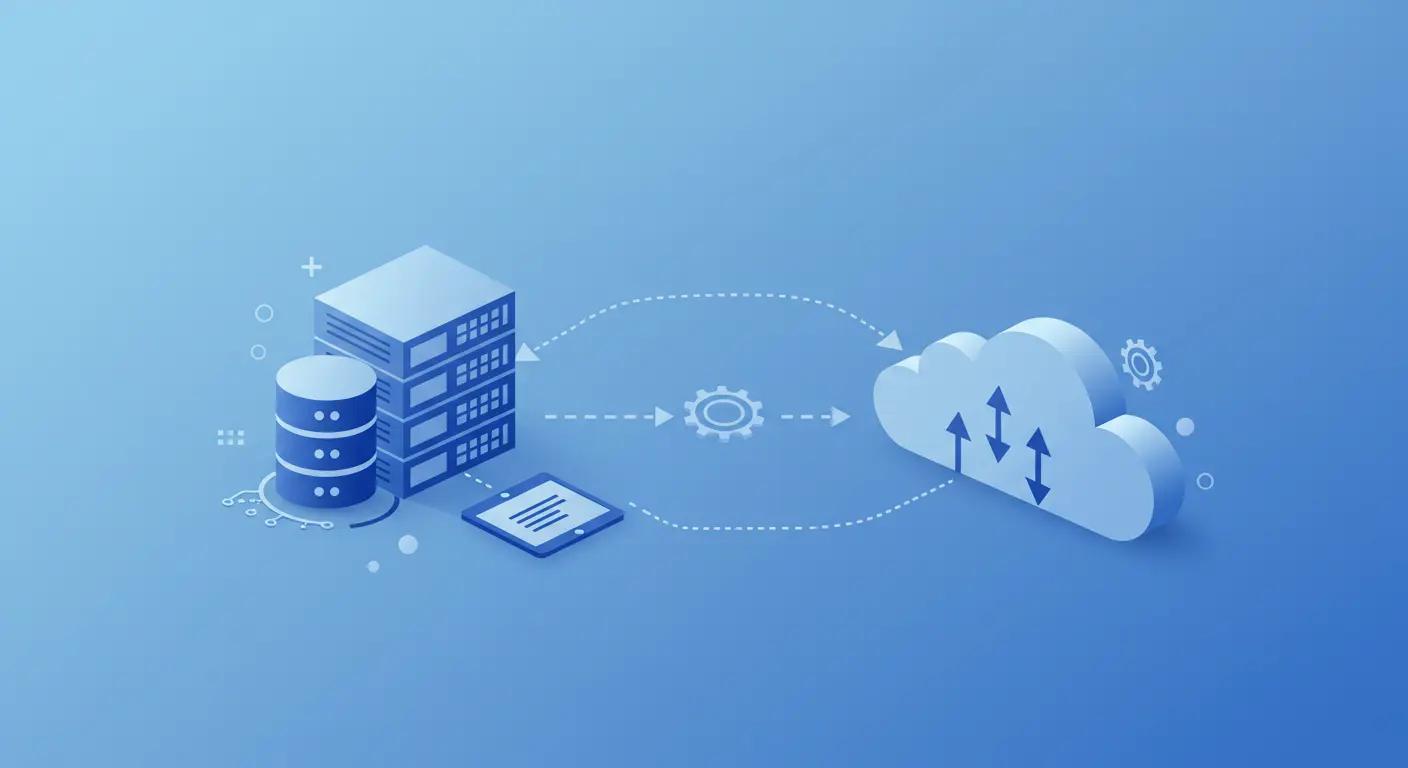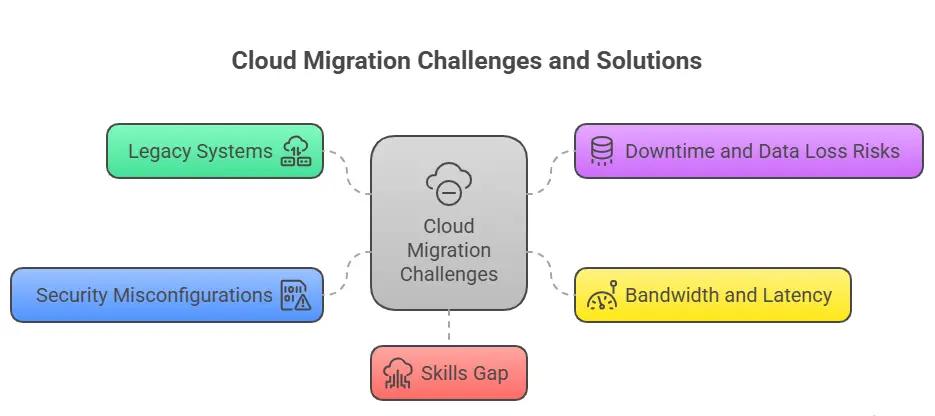
Cloud Migration is no longer optional; it's essential. In a world where agility, scalability, and digital transformation drive business success, migrating to the cloud is one of the smartest moves an organization can make. But how do you do it right? What are the real benefits, and what steps should you follow?
In this comprehensive guide, you’ll learn everything you need to know about Cloud Migration solutions, the Cloud Migration process, benefits, types, and how Wanclouds can help you streamline your digital transformation journey.
What is Cloud Migration?
Cloud migration is the process of moving digital assets, including data, applications, IT resources, and workloads, from on-premises or legacy infrastructure to a cloud environment like AWS, IBM Cloud, Azure, or Google Cloud.
This shift can involve moving entire data centers or individual services, depending on your organization’s needs. The goal is to improve scalability, security, and cost-efficiency by leveraging cloud technologies.
Key Takeaways:
- Cloud Migration is the process of moving data, applications, and workloads from on-premises infrastructure to cloud platforms.
- The top benefits of Cloud Migration include cost efficiency, scalability, better performance, enhanced security, and sustainability.
- Common Cloud Migration strategies include Rehosting, Replatforming, Refactoring, Repurchasing, Retiring, and Retaining.
- A successful Cloud Migration process follows three main steps: Assess, Mobilize, and Migrate & Modernize.
- Organizations often face challenges like technical complexity, data volume issues, and skills gaps, but these can be overcome with proper planning.
- Choosing the right Cloud Migration services is crucial for minimizing risk and maximizing ROI.
- Wanclouds offers tailored Cloud Migration Solutions for businesses looking to modernize their infrastructure quickly and securely.
Key Benefits of Cloud Migration
Migrating to the cloud offers numerous strategic and operational advantages. Below are the top benefits of Cloud migration:
1. Cost Savings
Cloud services eliminate the need to buy and maintain expensive physical servers. You only pay for what you use. This pay-as-you-go model drastically reduces IT overhead, energy costs, and long-term capital expenditures.
2. Scalability and Flexibility
Cloud environments are inherently scalable. Need more storage or computing power? Provide it in minutes. Scale up or down based on demand, without any hardware changes.
3. Improved Security
Leading cloud providers invest heavily in security protocols, including:
- End-to-end encryption
- Threat detection
- Identity and access management (IAM)
- Compliance with global standards like GDPR, HIPAA, and ISO
You benefit from enterprise-grade security, often better than what you can manage on-premises.
4. High Availability and Reliability
Cloud platforms offer automatic failover, disaster recovery, and load balancing across geographically distributed data centers. Your services remain up and running, even during outages.
5. Performance Optimization
With faster processing, globally distributed servers, and low-latency delivery via content delivery networks (CDNs), your applications run faster and deliver a better user experience.
6. Sustainability
Cloud providers are adopting green technologies and operating energy-efficient data centers. Cloud migration supports your company’s sustainability goals by reducing your carbon footprint.
What are the Types of Cloud Migration?
Cloud migration is not a one-size-fits-all process. Depending on your goals, resources, and technical landscape, you can choose from the 7 Rs of Cloud Migration to create a strategy that fits your organization best:
1. Rehost (Lift and Shift)
Move applications to the cloud without modifying their architecture. This is the fastest and most straightforward approach.
Best for: Quick migrations with minimal risk and when ROI needs to be proven early.
2. Replatform (Lift, Tinker, and Shift)
Make minor adjustments or optimizations to apps to better suit the cloud environment without changing core architecture.
Best for: Organizations seeking some cloud-native benefits without full refactoring.
3. Repurchase (Drop and Shop)
Replace existing applications with a SaaS (Software as a Service) alternative, usually involving retiring old licenses.
Best for: Outdated applications that have modern SaaS equivalents (e.g., Salesforce, Office 365).
4. Refactor / Re-architect
Redesign applications to fully leverage cloud-native features like microservices, serverless, containers, etc.
Best for: Apps that require high scalability, agility, or have performance issues on-prem.
5. Retire
Identify assets and applications that are no longer needed and can be safely decommissioned.
Best for: Reducing cost and complexity before or during migration.
6. Retain (Revisit)
Keep some applications in their current environment (on-premises or hybrid) when migration is not yet justified or needed.
Best for: Recently upgraded systems or those with unresolved dependencies.
7. Relocate
Move large-scale workloads without purchasing new hardware or rewriting apps, often using virtualization or containerization tools.
Best for: VMware-based environments or when time constraints prevent a full rebuild.
Each strategy has its pros and cons. The right choice depends on your business goals, application complexity, and cloud-readiness. For more information about the 7Rs of AWS Cloud Migration.
Cloud Migration Process: Step-by-Step
A successful Cloud Migration Process follows a structured path. Here’s how to do it right, in three main phases:
Phase 1: Assess
Before migrating, understand your current environment and set your migration goals.
Steps:
- Conduct a full IT audit
- Identify dependencies between systems
- Estimate cost and ROI
- Prioritize workloads based on business impact
- Choose the right cloud provider and services
Pro Tip: Use tools like AWS Application Discovery Service or Wanclouds' assessment tools for a complete evaluation.
Phase 2: Mobilize
Get your teams, tools, and infrastructure ready for migration.
Steps:
- Create a migration roadmap with timelines and deliverables
- Establish a Cloud migration team (cloud architects, DevOps, IT leads)
- Prepare a backup and disaster recovery strategy
- Set up your cloud environment and validate configurations
- Test-run with pilot workloads
Pilot migrations help uncover issues early and improve success for large-scale rollout.
Phase 3: Migrate & Modernize
Execute the migration and begin optimizing your cloud environment.
Steps:
- Move applications in waves, starting with low-risk ones
- Monitor app performance and user experience
- Re-architect or modernize workloads where needed
- Leverage cloud-native features (serverless, autoscaling, etc.)
- Implement automation, CI/CD pipelines, and cost monitoring tools
Remember: Cloud migration doesn’t end after the move. Ongoing optimization is key to maximizing ROI.

Common Cloud Migration Challenges
While Cloud migration offers enormous benefits, there are also challenges to navigate:
1. Legacy Systems
Some applications may not be compatible with cloud infrastructure and need refactoring or complete rebuilds.
2. Downtime and Data Loss Risks
Poor planning can lead to unexpected outages or data loss during migration. This is why testing and backups are critical.
3. Bandwidth and Latency
Transferring large amounts of data can be time-consuming and slow down operations if not planned correctly.
4. Security Misconfigurations
Security isn't automatic. Misconfigured access controls can expose sensitive data.
5. Skills Gap
Cloud technologies may be unfamiliar to your existing team. You’ll need proper training or a reliable cloud partner. Click here for more information.
Cloud Migration Services by Wanclouds
Wanclouds offers comprehensive, end-to-end Cloud Migration Services designed to simplify and accelerate your move to the cloud.
Whether you need to migrate a single application or an entire data center, Wanclouds provides:
- Cloud assessment and planning
- Security and compliance validation
- Multi-cloud and hybrid cloud support
- Live migrations with minimal downtime
- Cost optimization and resource right-sizing
Why Choose Wanclouds?
Wanclouds brings years of experience in cloud transformation across industries. We don’t just move your workloads, we modernize, secure, and optimize them.
Ready to Start Your Cloud Migration?
Wanclouds makes cloud migration simple, secure, and strategic. We help you plan, move, and modernize, without the stress.
- Get your free cloud migration assessment today
- Reduce downtime and maximize performance
- Partner with certified cloud experts you can trust